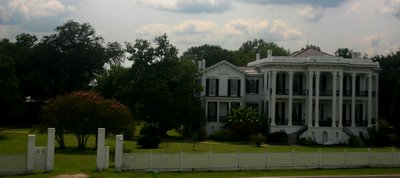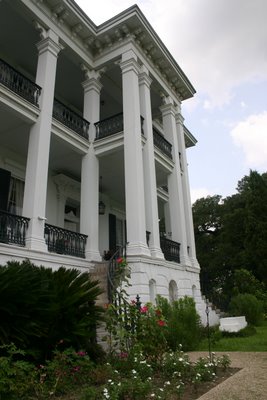Nine:
These are some of the plantations of Louisiana. I do not post them as a statement, or in disrespect of anyone or their ancestors. I post these photographs as an example of amazing and beautiful architecture, that has lasted generations, and may last for many more. These houses are open for tours, however, many do not allow photographs inside the houses. The only exception out of these that are shown is Nottoway, which is a bed and breakfast, and Laura, which was gutted by a fire before hurricane Katrina. I strongly recommend that anyone who sees these photos, and enjoys them, go to the plantations respective websites and look into visiting them. The entire New Orleans, Baton Rouge area is not completely devestated in the physical sense. They are, however, hurting in the economic sense because tourists are in short supply. There are beautiful places down there and contrary to popular northern beliefs, the Civil War is not still going on.

Oak Alley: This plantation is one of the most famous for it's alley of oak trees leading from the Mississippi river, to the front door of the house. While the house is not as grand as some other plantations, it is one of my absolute favorites for it's simple charm. The grounds reflect the simplicity of the building and it exudes an air of grace and charm that is in the breath of the place.


Nottoway: This is an amazing place. The building takes your breath away when you stand in front of it. This house has 53,000 square feet of actual home. It was built all at once and it is now a bed and breakfast. One of the interesting things about it, is they have turned the ruins of a fairly large kitchen (kitchens were not attached to the house for fear of fire back then) into a pool. There is a book, written by one of the daughters of the original owners under an assumed name, called "The White Castle of Louisiana" in which the daughter recalls her life on the plantation as a girl.


Houmas House: It has been called the "Sugar Palace" because it was a sugar plantation and appears to be a palace among the plantations of Louisiana. I consider this the most opulent of the houses I post here. The walls were painted in rich colors and it was beautiful, however, it felt cluttered, claustrophobic, there were too many antiques stuffed into the building. There is one room that guests are allowed to take photos of and that is the grand staircase shown above. The exterior and the gardens are what you REALLY want to see. For me, after seeing the outside, touring the interior was a bit of a let down because there is so much in the rooms. It does have one interesting thing in the collection that I had never seen; a vampire hunter's kit, complete with wooden stakes, crosses, and everything else a vampire hunter would need.


San Francisco: The name is not indicative of the California city. This plantation is one of the more unique mansions along the Mississippi in Louisiana and it is said that it looks like a riverboat. The two cisterns on either side of the house collect water and provide the house with a crude plumbing system, something very rare during the antebellum period. The back of the house was never finished because the builder died before the back gallery could be built, which is why on the second floor, there is a set of double doors which lead to nowhere. The reason why these are abstract photos is because when the levy and roadway was built in front of it in the 1930s, the engineers had to confiscate most of the front lawn, therefore, only about 60ft (a personal estimate) of front yard remains before road, then levy, then river. What is so sad is that the property is surrounded by an 8ft chain link fence with coiled barbed wire at the top. The fact that an Oil company owns it, may have something to do with the heightened level of security, but it is still heartbreaking to be unable to take a photograph of the outside without having the chainlink fence in the way.

Laura: This is a Creole plantation. The Creole people ran their plantations as what they were; businesses. The family which established this plantation (which is actually named after the last 'president' of the 'business') lived in New Orleans. These families did not pass the business to the oldest male, it was passed to the smartest of the next generation, and the plantation was run, primarily, by some particularly cagey women. Unfortunately, as memory serves, in 2004 this building was gutted by a fire caused by electrical spark. A majority of the artifacts were saved, but some precious ones were lost. This is a photo of the back of the house. The brickwork on the ground is amazing, especially around the stairs leading up to the house. Restoration is progressing slowly because workers in the New Orleans and Baton Rouge area are in short supply.

Oak Alley: This plantation is one of the most famous for it's alley of oak trees leading from the Mississippi river, to the front door of the house. While the house is not as grand as some other plantations, it is one of my absolute favorites for it's simple charm. The grounds reflect the simplicity of the building and it exudes an air of grace and charm that is in the breath of the place.


Nottoway: This is an amazing place. The building takes your breath away when you stand in front of it. This house has 53,000 square feet of actual home. It was built all at once and it is now a bed and breakfast. One of the interesting things about it, is they have turned the ruins of a fairly large kitchen (kitchens were not attached to the house for fear of fire back then) into a pool. There is a book, written by one of the daughters of the original owners under an assumed name, called "The White Castle of Louisiana" in which the daughter recalls her life on the plantation as a girl.


Houmas House: It has been called the "Sugar Palace" because it was a sugar plantation and appears to be a palace among the plantations of Louisiana. I consider this the most opulent of the houses I post here. The walls were painted in rich colors and it was beautiful, however, it felt cluttered, claustrophobic, there were too many antiques stuffed into the building. There is one room that guests are allowed to take photos of and that is the grand staircase shown above. The exterior and the gardens are what you REALLY want to see. For me, after seeing the outside, touring the interior was a bit of a let down because there is so much in the rooms. It does have one interesting thing in the collection that I had never seen; a vampire hunter's kit, complete with wooden stakes, crosses, and everything else a vampire hunter would need.


San Francisco: The name is not indicative of the California city. This plantation is one of the more unique mansions along the Mississippi in Louisiana and it is said that it looks like a riverboat. The two cisterns on either side of the house collect water and provide the house with a crude plumbing system, something very rare during the antebellum period. The back of the house was never finished because the builder died before the back gallery could be built, which is why on the second floor, there is a set of double doors which lead to nowhere. The reason why these are abstract photos is because when the levy and roadway was built in front of it in the 1930s, the engineers had to confiscate most of the front lawn, therefore, only about 60ft (a personal estimate) of front yard remains before road, then levy, then river. What is so sad is that the property is surrounded by an 8ft chain link fence with coiled barbed wire at the top. The fact that an Oil company owns it, may have something to do with the heightened level of security, but it is still heartbreaking to be unable to take a photograph of the outside without having the chainlink fence in the way.

Laura: This is a Creole plantation. The Creole people ran their plantations as what they were; businesses. The family which established this plantation (which is actually named after the last 'president' of the 'business') lived in New Orleans. These families did not pass the business to the oldest male, it was passed to the smartest of the next generation, and the plantation was run, primarily, by some particularly cagey women. Unfortunately, as memory serves, in 2004 this building was gutted by a fire caused by electrical spark. A majority of the artifacts were saved, but some precious ones were lost. This is a photo of the back of the house. The brickwork on the ground is amazing, especially around the stairs leading up to the house. Restoration is progressing slowly because workers in the New Orleans and Baton Rouge area are in short supply.

0 Comments:
Post a Comment
<< Home